The turtle has always had a unique status in Chinese culture, and its status is very noble. Turtle, dragon, phoenix and lin are collectively called the Four Spirits. The turtle is regarded as a symbol of longevity, as mentioned in Cao Cao's "The Turtle is Longevity". Turtles were also regarded as a medium between humans and gods. Shamans from the Yin and Shang Dynasties burned tortoise shells to predict good and bad luck, and then carved the divination contents on turtle boards, leaving behind the early Chinese characters - oracle bone inscriptions. Today turtles are primarily pets, food, and endangered species. The turtle is familiar to the public, but I don’t know how many people have carefully observed its body structure.
In order to resist attacks, four-legged animals put armor on their body surfaces - among mammals there are living armadillos and extinct glyptodonts, among dinosaurs there is Ankylosaurus, and among marine reptiles there is Acrodon; and armor is the most The most complete animal is the turtle. The bony plates that cover the body of other animals are derived from the skin, but turtle shells are derived from multiple parts of the skeleton and are closely related to the internal structure. The turtle shell is divided into two parts, the dorsal and ventral parts. The dorsal part is called the carapace and the ventral part is called the plastron. Except for secondary degeneration, they are generally divided into two layers: the outer layer is horny and is composed of many scutes; the inner layer is bony and is composed of many bone plates. Its carapace heals with the spine and ribs, which are located outside the shoulder girdle and girdle. This allows it to retract its head, limbs and tail into its shell. In addition to a unique shell, the turtle's skull is also unique. In amniotes, the arrangement of the four bones, postorbital, squamous, yoke, and parietal, is the main basis for classification. There are three basic types: If these four bones are a whole and there is no perforation in the middle, it is non-porous. type; if there is a temporal foramen between the postorbital bone, squamous bone, and yule bone, it is a hypoforamen type; and if there are two holes, it is a biforamen type. The temporal region of the skull of living turtles is open, but there is no temporal arch, which is inconsistent with the typical types.

Comparison of the glans skull with three types of early amniotic skulls: A. aperforate skull, B. hypoforaminal skull; C. bifenestrated skull (abbreviations: L, inferior temporal foramen; Or, orbit; P, parietal; Po, postorbital bone; S, superior temporal foramen; Sq, squamous bone)

Protognathus fossil, upper right is the top view of the skull
How did the turtle's unique head and body structure form? This includes two issues. First, what are the ancestors of turtles? This is a question of origin. Second, how did turtles evolve step by step from ancestors whose structure was not much different from that of ordinary four-legged animals? These two questions must be answered by fossils. As early as more than a hundred years ago, people had discovered a turtle from more than 200 million years ago (Late Triassic) in Germany: Proganochelys. People can easily classify it as a turtle because it already has a complete dorsal and ventral carapace; however, its skull has a complete temporal area, so turtles have long been classified as anaporids. This has been the mainstream view for more than a hundred years, so paleontologists generally look for the ancestors of turtles among the anaporids. In 1914, Watson summarized the common characteristics of turtles and proposed the shape that their ancestors should have. Then he specifically pointed out that Eunotosaurus (once translated as Eunotosaurus) with eight pairs of specialized ribs was likely to be the ancestor of turtles. In 1946, Gregory compared turtles with early reptiles and believed that turtles originated from cuposaurs (including seriodontosaurs, anosaurids, simonosaurs and other groups), among which turtles and seriodontosaurs are more closely related than platyodontosaurs. close. Olson proposed in 1947 that turtles originated from platyodontids. Many people once accepted the view that turtles are more closely related to lizards, such as Romer, who classified lizards into the order Turtles in his classic "Osteology of Reptiles". After the rise of cladistic systematics, many analyzes also support that turtles are parareptiles and are closer to seriodontosaurs or anosaurs; some have also suggested that turtles are most closely related to macrorhinosaurs. However, neither the serodontosaur nor the prosaurus theory can explain the origin of the turtle's unique shell, and it is unconvincing.

Skull (top) and backbone of lizard (bottom)
Some scholars also believe that turtles should belong to the amphipods. Goodrich (1916) believed that reptiles are divided into two branches, one is called Sauropsida (including birds), and the other is Theropsida (including mammals). Turtles are classified as the former because of the hook shape of the fifth metatarsal bone and the structure of the heart. He believed that the turtle's skull was inconsistent with a true anastomosis. Some modern zoologists believe that turtles are diapsids based on the jaw adductor muscles, while deBeer (1937) and others further believed that turtles are related to archosaurs (such as crocodiles) based on the development results of the lateral vertebral bodies of the anterior annular vertebra and the secondary subclavian artery. species, birds, and fossil relatives) are more closely related. Rieppel carefully analyzed many morphological characteristics of living biology (many of which are soft body characteristics) and believed that most of them did not hold true. When deBraga and Rieppel (1997) analyzed the relationship between amniotes, they found that turtles are very closely related to the Mesozoic marine reptiles pterosaurs, which are at the base of the lepidosauromorphs (cuneiform lizards, lizards and fossil relatives). This is consistent with current biology, especially molecular biology research, which classifies turtles as diapsids, but the latter supports that turtles are closer to crocodiles and birds than to lizards. Werneburg and Sanchez-Villagre (2009) believed that turtles occupy a basal position among living reptiles based on the analysis of the sequence of external morphological development during embryonic development.
The origin of turtles also involves an environmental issue: Were the earliest turtles of aquatic or terrestrial origin? Triassic turtle fossils have been found in Argentina, Germany, and Thailand, all in terrestrial strata. Moreover, studies on the forelimbs, shell morphology and shell histology of the complete fossils Protognathus and Palaeochersis support that these two early turtles were terrestrial, so some people support the theory of the terrestrial origin of turtles. Rieppel and Reisz (1999) proposed that turtles are of aquatic origin based on their breathing patterns, movement patterns, and plastron.
Regardless of which group the turtle is more closely related to, the origin of the turtle's unique morphology must be explained. Cuvier (1799, 1812) was the first to propose that the middle part of the tortoise shell, namely the lamina and ribs, is connected by bony sutures formed by the neural arch of the dorsal vertebrae and the widening of the dorsal ribs. Owen and others believe that the turtle shell originates from dermal ossification, and its sinking and healing of the axial skeleton. These earliest controversies were based on embryological studies. Later, the leatherback turtle was regarded as a primitive stage of turtle shell evolution, and the mistaking of Celadon as a turtle led researchers to stick to the dermal ossification theory. After more than a hundred years of developmental research, there is still no answer to this question. Some people believe that the lamina and ribs seem to be mixed with endoskeleton and osteoderm during development. In addition, the results seem to be different for different taxa. When Gilbert studied red-eared turtles and snapping turtles, he proposed that turtle shells evolved from the epidermis. When Kuratani's team studied turtles in 2013, they found that the shells came from internal bones, not from the epidermis or exoskeleton.
This controversy is also relevant to reconstructing the ancestors of turtles. If the origin of turtle shells is related to skin and bones, then the ancestors of turtles should be found in this group. Protognathus has a complete shell and skin and bones, which does not help solve this problem. In 2008, Li Chun and other scholars discovered several fossils in Guanling limestone in Guizhou. After repairing them, they found that they were turtles, but they did not have a complete carapace and had teeth. They were named Hemicodon. It has a complete plastron, while the carapace only has a neural plate, and the dorsal ribs are broadened, but there are no skin bones. This is consistent with the embryonic development stage of living turtles, and the shell is not formed by the healing of skin and bones. This fossil lived at the edge of the ocean or in a delta, which may indicate that turtles originated in the water. This fossil pushes the appearance of the turtle to about 220 million years ago, but its skull is poorly preserved and non-porous, providing no new information in this regard. However, some scientists have questioned that the incomplete shell of the turtle's shell may be due to adaptation to aquatic life. Recently, new turtle fossils were discovered in Guanling, which may give us some new explanations.
Due to the discovery of the semi-armored turtle, paleontologists no longer believe that the formation of turtle shells is related to the skin and bones, and return their attention to the australian lizard about 260 million years ago. Lyson, Bever and others pointed out that the lizard had some unique features with turtles in the bones behind its head, such as nine lengthened trunk vertebrae, nine pairs of widened T-shaped ribs, the loss of intercostal muscles, etc. Their preliminary analysis in 2013 still listed turtles among the parareptiles. Later, detailed analysis of the skull of the lizard also supported the close genetic relationship between the turtle and the lizard; it was also found that the larvae of the lizard had both upper and lower temporal holes, but they were covered by other bones in the adult. The final results supported that both lizards and turtles were diapsids, and the paper was published in the journal Nature in 2015. Recently, some specimens were discovered in Germany, named Pappochelys, with an age of 240 million years. They are considered to be intermediate in age and structure between the Austrosaurus and the Hemicodon. It still has a superior temporal foramen and an open inferior temporal foramen. This fossil indicates that the plastron may have been formed by the convergence of peritoneal ribs. This fossil is abundant in lake sediments, indicating that it lived near water or often entered water.
Current research tends to agree that turtles belong to the diapseids. However, the position of turtles among the diapsids has not yet been resolved: whether it is a branch of archosaurs, a branch of lepidosaurs, or a more basic position outside the two branches. In the results of Bever et al. in 2015, the parsimony method supports that it is located in the lepidosaur branch, while Bayes' rule supports that it is located outside the diapsoid crown group. Previous molecular biology has supported that it is more closely related to archosaurs (crocodiles, birds), but if genes are regarded as traits, several possibilities have emerged. We still need more fossils and more comprehensive and in-depth research to solve these problems.
We created this article in conjunction with AI technology, then made sure it was fact-checked and edited by a Animals Top editor.